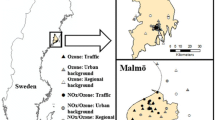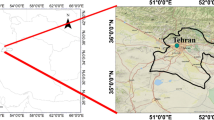Abstract
This study provides an analysis of the spatial distribution and trends of NO, NO2 and O3 concentrations in Portugal between 1995 and 2010. Furthermore, an estimation model for daily ozone concentrations was developed for an urban and a rural site. NO concentration showed a significant decreasing trend in most urban stations. A decreasing trend in NO2 is only observed in the stations with less influence from emissions of primary NO2. Several stations showed a significant upward trend in O3 as a result of the decrease in the NO/NO2 ratio. In the northern rural region, ozone showed a strong correlation with wind direction, highlighting the importance of long-range transport. In the urban site, most of the variance is explained by the NO2/NOX ratio. The results obtained by the ozone estimation model in the urban site fit 2013 observed data. In the rural site, the estimated ozone during extreme events agrees with observed concentration.







Similar content being viewed by others
References
Alves CA, Lopes DJ, Calvo AI, Evtyugina M, Rocha S, Nunes T (2015) Emissions from light-duty diesel and gasoline in-use vehicles measured on chassis dynamometer test cycles. Aerosol Air Qual Res 15:99–116. doi:10.4209/aaqr.2014.01.0006
Alvim-Ferraz MCM, Sousa SIV, Pereira MC, Martins FG (2006) Contribution of anthropogenic pollutants to the increase of tropospheric ozone levels in the Oporto Metropolitan Area, Portugal since the 19th century. Environ Pollut 140:516–524. doi:10.1016/j.envpol.2005.07.018
Beal DJ (2007) Information criteria methods in SAS® for multiple linear regression models. SESUG 2007: The Proceedings of the Southeast SAS Users Group, Hilton Head, South Carolina, USA
Borrego C, Sá E, Ferreira J, Miranda AI (2009) Forecasting human exposure to atmospheric pollutants in Portugal—a modelling approach. Atmos Environ 43:5796–5806. doi:10.1016/j.atmosenv.2009.07.049
Camalier L, Cox W, Dolwick P (2007) The effects of meteorology on ozone in urban areas and their use in assessing ozone trends. Atmos Environ 41:7127–7137. doi:10.1016/j.atmosenv.2007.04.061
Carslaw C, Rhys-Tyler G (2013) New insights from comprehensive on-road measurements of NOX, NO2 and NH3 from vehicle emission remote sensing in London, UK. Atmos Environ 81:339–347. doi:10.1016/j.atmosenv.2013.09.026
Carvalho A, Monteiro A, Ribeiro I, Tchepel O, Miranda A, Borrego C, Saavedra S, Souto JA, Casares JJ (2010) High ozone levels in the northeast of Portugal: analysis and characterization. Atmos Environ 44:1020–1031. doi:10.1016/j.atmosenv.2009.12.020
Colvile RN, Hutchinson EJ, Mindell JS, Warren RF (2001) The transport sector as a source of air pollution. Atmos Environ 35:1537–1565. doi:10.1016/S1352-2310(00)00551-3
Dunn OJ (1964) Multiple comparisons using rank sums. Technometrics 6:241–252
Ferreira F, Tente H, Torres P, Mesquita S, Santos E, Esgalhado F, Jardim D (2001) Background levels of sulphur dioxide, nitrogen dioxide and ozone in Portugal. International conference Measuring Air Pollutants by Diffusive Sampling, Montpellier, France
Gonçalves C, Alves C, Pio C (2012) Inventory of fine particulate organic compound emissions from residential combustion in Portugal. Atmos Environ 50:297–306. doi:10.1016/j.atmosenv.2011.12.013
Gordon M, Vlasenko A, Staebler RM, Stroud C, Makar PA, Liggio J, Li S-M, Brown S (2014) Uptake and emission of VOCs near ground level below a mixed forest at Borden, Ontario. Atmos Chem Phys 14:9087–9097. doi:10.5194/acp-14-9087-2014
He H, Lu WZ (2011) Decomposition of pollution contributors to urban ozone levels concerning regional and local scales. Build Environ 49:97–103. doi:10.1016/j.buildenv.2011.09.019
Hocking RR (1976) The analysis and selection of variables in linear regression. Biometrics 32:1–49
Hubbard MC, Cobourn WG (1998) Development of a regression model to forecast ground-level ozone concentration in Louisville, KY. Atmos Environ 32:2637–2647. doi:10.1016/S1352-2310(97)00444-5
Judge OG, Griffith WE, Hill RC, Lee CH, Lütkepohl H (1985) The theory and practice of econometrics. Wiley, New York
Keuken MP, Roemer MGM, Zandveld P, Verbeek RP, Velders GJM (2012) Trends in primary NO2 and exhaust PM emissions from road traffic for the period 2000-2020 and implications for air quality and health in the Netherlands. Atmos Environ 54:313–319. doi:10.1016/j.atmosenv.2012.02.009
Kruskal WH, Wallis WA (1952) Use of ranks in one-criterion variance analysis. J Am Stat Assoc 47:583–621
López G, Ballesteros R (2003) Efectos de la exposición al ozono en personas con enfermedades cardiovasculares en Mexicali, BC. Revista de la Facultad de Medicina UNAM 46:22–225 (in Spanish)
Mardia KV (1976) Linear-circular correlation and rhythmometry. Biometrika 63:403–405
Marenco A, Gouget H, Nédélec P, Pagés J-P (1994) Evidence of a long-term increase in tropospheric ozone from Pic du Midi data series: consequences: positive radiative forcing. J Geophys Res 99:16617–16632. doi:10.1029/94JD00021
Mavroidis I, Chaloulakou A (2011) Long-term trends of primary and secondary NO2 production in the Athens area. Variation of the NO2/NOX ratio. Atmos Environ 45:6872–6879. doi:10.1016/j.atmosenv.2010.11.006
Mavroidis I, Ilia M (2012) Trends of NOX, NO2 and O3 concentrations at three different types of air quality monitoring stations in Athens, Greece. Atmos Environ 63:135–147. doi:10.1016/j.atmosenv.2012.09.030
Melkonyan A, Kuttler W (2012) Long-term analysis of NO, NO2 and O3 concentrations in North Rhine-Westphalia, Germany. Atmos Environ 60:316–326. doi:10.1016/j.atmosenv.2012.06.048
Monsalve F, Tomas C, Fraile R (2013) Influence of meteorological parameters and air pollutants onto the morbidity due to respiratory diseases in Castilla-La Mancha, Spain. Aerosol Air Qual Res 13:1297–1312. doi:10.4209/aaqr.2012.12.0348
Monteiro A, Miranda AI, Borrego C, Vautard R (2007) Air quality assessment for Portugal. Sci Total Environ 373:22–31. doi:10.1016/j.scitotenv.2006.10.014
Russo A, Trigo RM, Martins H, Mendes MT (2014) NO2, PM10 and O3 urban concentrations and its association with circulation weather types in Portugal. Atmos Environ 89:768–785. doi:10.1016/j.atmosenv.2014.02.010
Sen PK (1968) Estimates of the regression coefficient based on Kendall’s tau. J Am Stat Assoc 63:1379–1389
Sneyers R (1990) On the statistical analysis of series of observations. WMO Tech Note 143:10–15
Acknowledgments
The authors wish to thank the Agência Portuguesa do Ambiente (QualAr) for providing pollutants data and Dr. Claire Thomas at Transvalor S.A. for providing solar radiation data series. This study was partially supported by the Spanish Ministerio de Economía y Competitividad (Grants TEC2014-57821-R and CGL2014-52556-R), by FEDER funds through the Programa Operacional Factores de Competitividade (COMPETE) and by Portuguese national funds through Fundação para a Ciência e a Tecnologia (FCT), within the framework of the CLICURB project “Urban Atmospheric Quality, Climate Change and Resilience” EXCL/AAGMAA/0383/2012. The University of León has also partially supported this study through the Programa Propio 2015. E. Alonso-Blanco acknowledges the FPI grant to carry out the doctoral thesis/PhD at the Research Centre for Energy, Environment and Technology (CIEMAT).
Author information
Authors and Affiliations
Corresponding author
Additional information
Responsible editor: Constantini Samara
Electronic supplementary material
Below is the link to the electronic supplementary material.
ESM 1
(PDF 705 kb)
Rights and permissions
About this article
Cite this article
Fernández-Guisuraga, J.M., Castro, A., Alves, C. et al. Nitrogen oxides and ozone in Portugal: trends and ozone estimation in an urban and a rural site. Environ Sci Pollut Res 23, 17171–17182 (2016). https://doi.org/10.1007/s11356-016-6888-6
Received:
Accepted:
Published:
Issue Date:
DOI: https://doi.org/10.1007/s11356-016-6888-6




